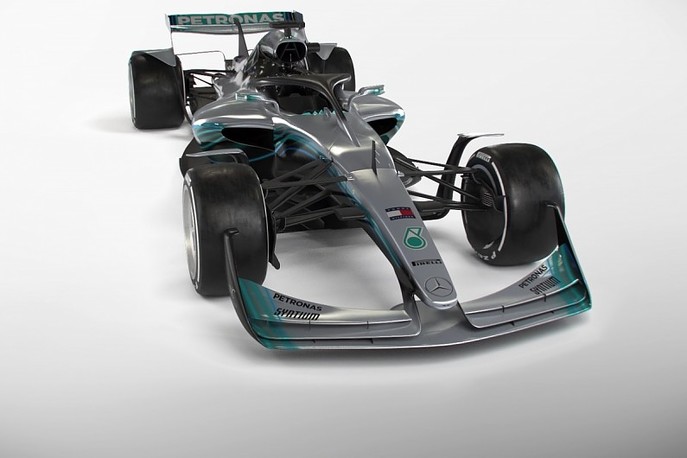2021 Formula 1 concept claimed to produce five-times less dirty air

Formula 1 is now on course to reduce the impact of dirty air on performance by up to five times with its 2021 regulations, sporting director Ross Brawn has revealed.
F1's switch to higher-downforce cars in 2017 triggered a reduction in overtaking and wheel-to-wheel action, as drivers struggled to run close behind other cars due to an increased loss of performance from turbulence.
Raising the quality of racing has been a primary aim for the championship's next rules cycle and, while F1 has already introduced a raft of changes aimed at increasing overtaking for 2019, the series chiefs have promised a much more substantial impact from the 2021 rules.
When F1's initial 2021 car concepts were launched in Singapore last year, Brawn said F1 had designs that would allow cars to keep as much as 80% of their performance in dirty air - but ahead of this year's campaign he offered an estimate that was bigger still.

"There's a massive difference already," he said. "With the current car, two car lengths behind, you lose 50% of the performance.
"The car we have [in the works] now, you lose 10% of the performance.
"So it's a huge improvement over where we are today."
The true impact of dirty air is difficult to measure precisely, with the FIA's head of single-seater matters Nikolas Tombazis having estimated that 2018 cars lost only "about 30%" of their downforce while following another car "15 to 20 metres back" - as opposed to Brawn's suggestion of 50% at two car lengths.
Tombazis had targeted a one-third decrease in performance loss with this year's rules.
An overall reduction of downforce has been frequently mooted as a solution to F1's current overtaking woes, but Brown believes this would not be conceptually appropriate.
"I've heard it commented that we should get rid of the wings and the downforce and just rely on mechanical grip and then the cars will be able to race each other," Brawn said.
"The problem with that is they'll be slow. And the speed of the Formula 1 car is what takes your breath away.
"We don't want to lose the speed of the Formula 1 car. We want it to be the fastest racing car on the planet, the most impressive racing car on the planet - and you can only do that by harnessing the aerodynamic performance.
"So I don't think we can take a simplistic view and just get rid of all the downforce and think that'll solve it.
"What we need is the downforce to be delivered in a way that cars can race each other.
"Overtaking can sometimes be used as the measure of success, but in fact close racing and the ability of cars to run behind each other and run side by side and get close and attack is the thing that everyone gets excited about - even if it ultimately didn't culminate in overtaking being achieved, but they're fighting each other."
Zdroj: autosport.com
Diskusia k článku
Najnovšie galérie
































 Miroslav
Miroslav 
 Branislav
Branislav  Alexandre
Alexandre 
 Thomas
Thomas 
 Bohumír
Bohumír